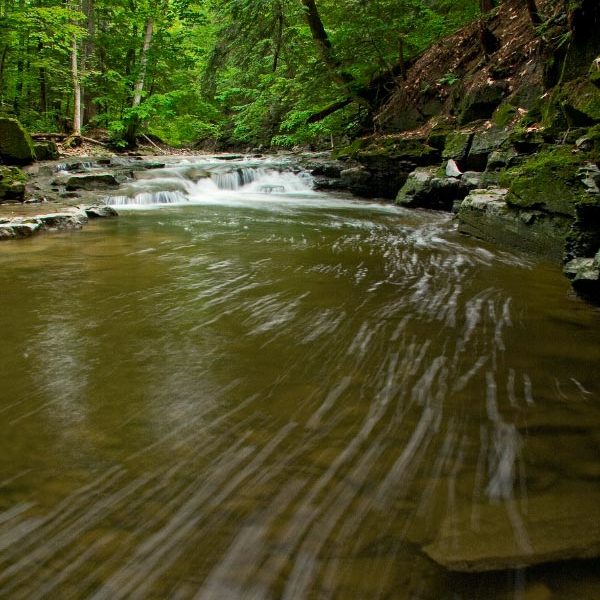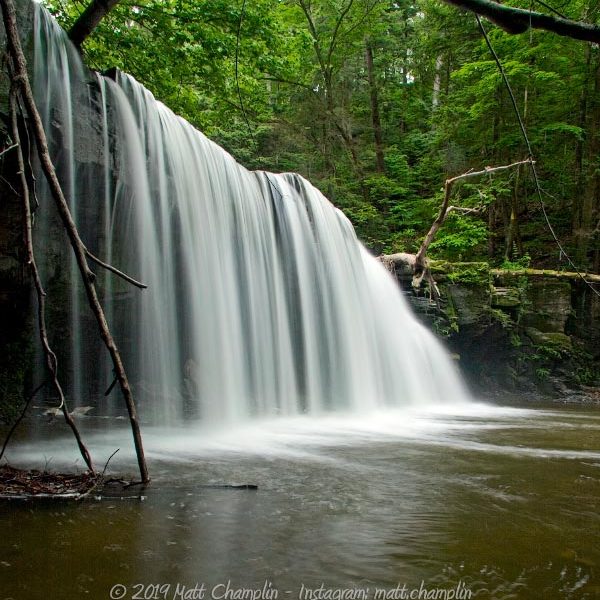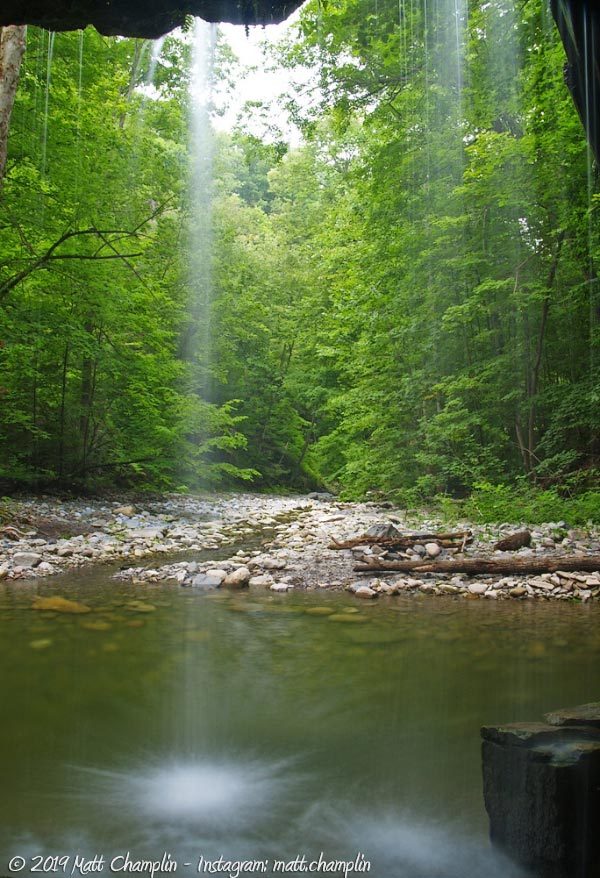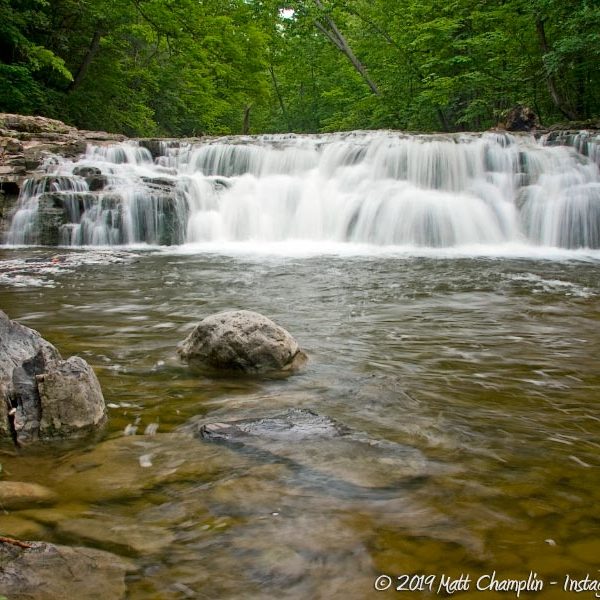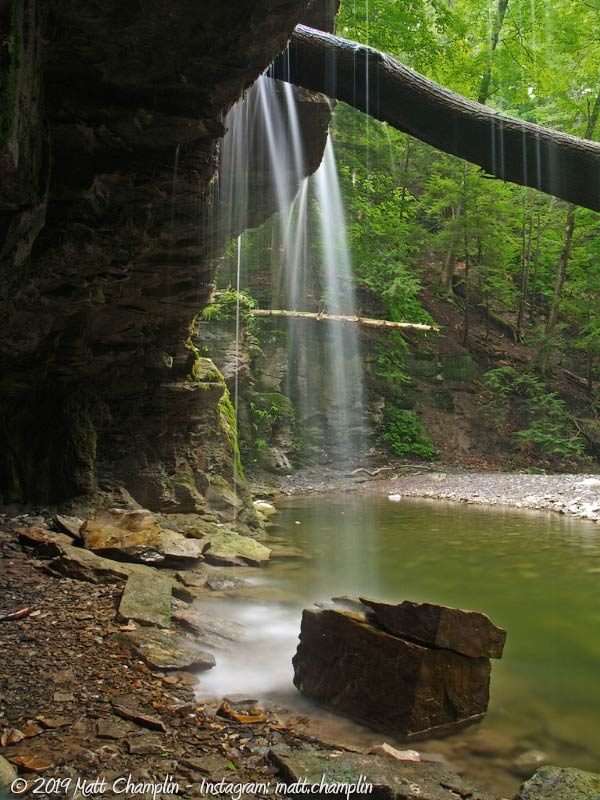Great Gully
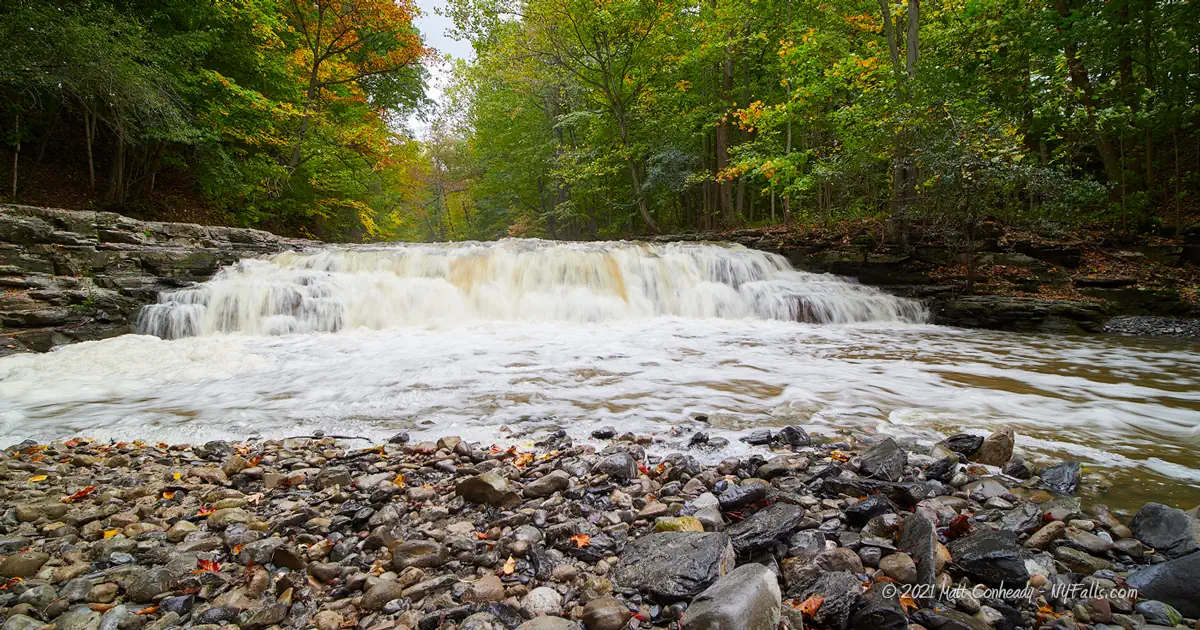
Location: Town of Springport; south of Union Springs, Cayuga County, New York.
Maps: Google Map; Topographic; Interactive.
GPS Coordinates:
- Parking: N 42.80812 / W 76.70188
- Lower Falls: N 42.80770 / W 76.70038
- Upper Falls: N 42.80764 / W 76.69017
Directions: Take Ny-90 (South from NY-5/20) along the eastern side of Cayuga Lake for about 10 miles. Depending on direction, you will see a pull-off on the east side of the road with various historical markers detailing Cayuga villages and Sullivan’s campaign against the Iroquois during the American Revolution. South of these markers, before the bridge that crosses Great Gully Creek is the parking area.
Or use Google Maps.
Parking: Roadside parking in a grassy area alongside NY-90 to the north of the creek. Space for roughly 15 cars.
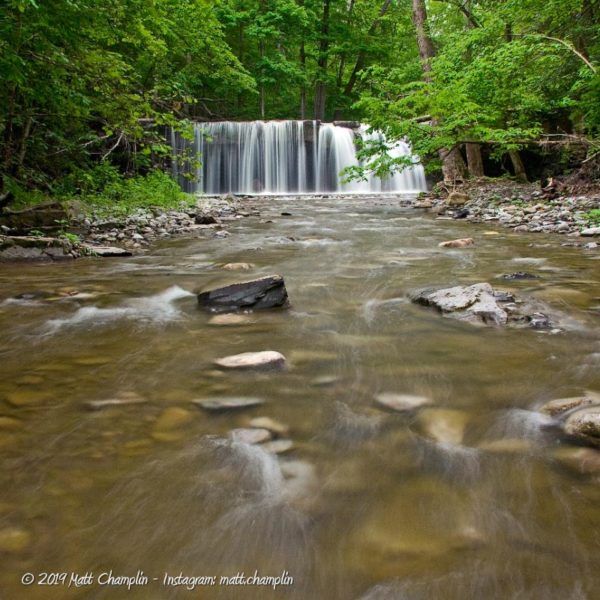
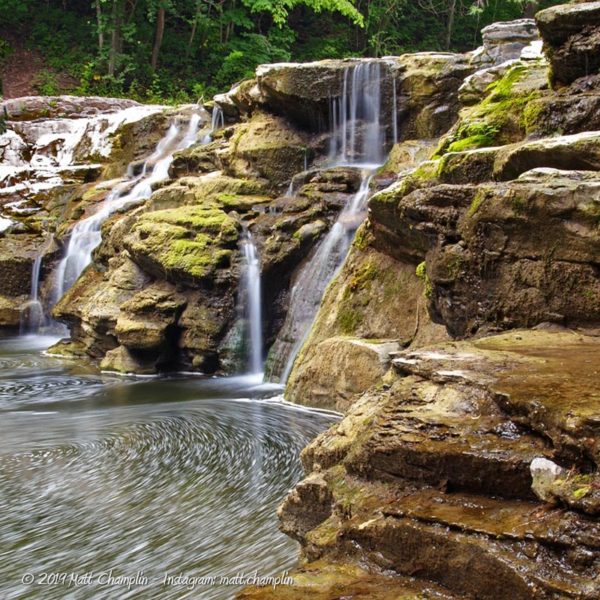
Weather
Information / Accessibility / Accommodations
Description
Accurately named for its massive size, Great Gully encompasses over 25 square miles of watershed (80% of which is developed). It travels over 4 miles, dropping over 460 feet into Cayuga Lake. You cannot hike the length of the gully. It is mostly privately owned, but you can visit the section from the parking area up to the second falls, that the private landowner has kept open to public access
Great Gully cuts through massive layers of limestone, giving it a different look from shale-based waterfalls found in many of the other Finger Lakes gorges. The dropping and swirling water of Great Gully Creek has carved out several deep pools that maintain a significant depth throughout even the hottest summer months.
The Lower Falls is very wide, cascading down a short 8 ft drop into a large and popular swimming hole. The Upper Falls has a very large, thick limestone cap rock over which the creek plunges 18 ft over a sizable cave. There is a refreshing swimming hole at the base of the Upper Falls.

History
The area around Great Gully, Aurora, and Union Springs is rife with history. Even before the Iroquois Confederacy was formed, areas around the Cayuga Lake’s Frontenac Island have yielded evidence of ancient and elaborate burial grounds, consisting of bone-carved sculptures, combs, and flutes that point to habitation thousands of years before the Cayugas called the place home.
Before Europeans entered the area, the Cayuga ‘castle’ of Goiogouen was located right to the north of Great Gully. This was a large and principal village that consisted of over 15 longhouses and numerous corn fields and orchards. The early French settlers in the area also built a Jesuit mission at this site. Early European settlers wrote accounts of the plentiful salmon and freshwater eels present in tributaries along Cayuga Lake, including Great Gully Creek. Undoubtedly, the earliest inhabitants of the area used the Great Gully area for swimming, fishing, and drinking.
South of Goiogouen, in what is present-day Aurora, stood the Cayuga village of Chonodote which was known as ‘Peachtown’ to the Americans because of the huge orchard of over 1,000 peach trees. During the American Revolution, four of the five nations of the Haudenosaunee sided with the British during the war, leading George Washington to direct John Sullivan and George Clinton to undertake what is now known as the Sullivan Expedition against the Iroquois and Loyalists in the area of Upstate New York.
Orders of George Washington to General John Sullivan, at Head-Quarters May 31, 1779
The Expedition you are appointed to command is to be directed against the hostile tribes of the Six Nations of Indians, with their associates and adherents. The immediate objects are the total destruction and devastation of their settlements, and the capture of as many prisoners of every age and sex as possible. It will be essential to ruin their crops now in the ground and prevent their planting more. I would recommend, that some post in the center of the Indian Country, should be occupied with all expedition, with a sufficient quantity of provisions whence parties should be detached to lay waste all the settlements around, with instructions to do it in the most effectual manner, that the country may not be merely overrun, but destroyed. But you will not by any means listen to any overture of peace before the total ruinment of their settlements is effected. Our future security will be in their inability to injure us and in the terror with which the severity of the chastisement they receive will inspire them.
The Clinton-Sullivan campaign had one goal – the destruction of the Iroquois Nation as a viable entity. In this they succeeded in destroying over forty villages throughout upstate New York, including the ones by Great Gully and Aurora, effectively ending the existence of the Iroquois confederacy as a nation. Most of the former inhabitants settled on reservations at the north end of Cayuga Lake. The Iroquois (Haudenosaunee, their own name for themselves) Confederacy still exists and maintains their traditional system of governance today.
After the war, the area around Great Gully was included in the Central New York Military Tract, which were land grants given in lieu of payment to Continental soldiers. Settlement began in the late 1700’s, with towns popping up along numerous ‘ferries’ on the shore of Cayuga Lake – the only means of transportation at the time. The nearby village of Cayuga, NY, north of Great Gully, once had one of the longest bridges in the world, built in 1800 that spanned Cayuga Lake. The bridge was at one time considered the best public improvement project in New York State. The Cayuga bridge linked more developed eastern areas to the ‘frontiers’ of the West – and armies fighting in the War of 1812 passed on their way over the mile-long bridge.
Once the Cayuga-Seneca Canal was completed and linked with the nearby Erie Canal, villages such as Aurora and Union Springs began to prosper and grow while ferry and bridge travel began to decline. Union Springs was once known for its numerous sulfur and mineral springs which people came to for supposed health benefits. Nearby in Aurora, a stopping point for canal traffic, a boom-town atmosphere developed. Many famous residents called Aurora home, including the founder of Wells-Fargo, Henry Wells; Edwin B. Morgan, a founder of the New York Times, former first lady Frances Cleveland, and anthropologist Laura Nader. Aurora is also home to the prestigious Wells College, formerly an all-women’s school that recently opened its doors to men. Aurora also has the famous Mackenzie-Childs, maker of fine dining ware.
The areas around Great Gully continue to prosper thanks to the booming wine-trade that has sprung up on the shores of Cayuga Lake. This small portion of Great Gully and some acreage surrounding is protected by the Nature Conservancy. In 2013, the Finger Lakes Land Trust acquired an easement in a partnership with Great Gully Farms to help protect the Gully where the falls are.
Hiking / Walking Trails
Difficulty: Moderate.
Markings: None.
Distance: About a mile and a half to the upper falls and back.
Description: The lower falls has a very defined trail leading to it from the parking area only 200 yards from Rt 90. To reach the rest of the ravine, creek-walking is required, but there are some areas with defined trails along the shore of the creek. Another swimming hole can be found 1/3 mile from the Lower Falls. Further up the creek about another 1/3 mile you will reach the Upper Falls. Note: public access ends beyond the second falls, so please refrain from climbing up the ravine, so the public may continue to enjoy the falls for generations to come.
The rock on Great Gully Creek is smooth, hard limestone with numerous cracks and holes. Walking in the creek bed can be slippery, so use caution.
Map: Interactive.
Great Gully Interactive Map
Great Gully Media
Coming soon…
Interesting Stuff
MacKenzie-Childs
MacKenzie-Childs is located on a 65-acre former dairy farm overlooking Cayuga Lake in the heart of the Finger Lakes region. The grounds, open to the public, house their production studio, a Second-Empire farmhouse, open for tours, and a retail shop filled with MacKenzie-Childs tableware, home furnishings, and gifts.
Cayuga Lake Wine Trail
Take a trip down one side and up the other to get the full experience. Participating wineries offer activities, free collectors items and excellent hospitality. Many chauffeured tours are offered and it is recommended you try them if you plan on drinking much. cayugawinetrail.com
Photography Tips
Capturing the falls
- The Great Gully ravine is heavily forested and relatively deep, which allows for darker conditions than would normally prevail in the open on sunny days. Therefore it may be possible to get excellent shots of the waterfalls on sunny days – especially early in the morning and later in the afternoon.
- The Lower Falls is more open to the light and it has a less distinct water flow, especially in the summer when it is barely a trickle. Photographing to the right of the waterfall, closer to the water makes for better shots, especially when you include some of the distinct bedrock and swirling suds in the pool below. It is very popular with swimmers, so you may not be able to get a shot without people in it, unless you get there pretty early.
- The Upper Falls is very unique and has numerous angles that you can try shooting. Attempt to offset the falls in the frame, including the pool, stream bed, logs, or the moss that abounds around the falls. In late summer, the water flow is low so be sure to try to get as long a shutter speed as possible. Use a Polarizer and graduated Neutral Density filter to offset any light you get from the top of the gorge in the frame.
- Try shooting in the gorge on the journey back. There are numerous small cascades and sheer walls that make for excellent shots.
Getting wet
- Be sure to carry your camera in a waterproof pack. You’ll have to tread through water.
Silky Water Effect
- To get that smooth cotton-candy look to the falls, you need to use a Neutral Density (ND) filter on your lens. The ND filter will block some of the light from entering the lens without altering the color, and thus allow your shutter to stay open longer. This blurs the water and creates a soft white gloss to the foamy areas of the falls. Check out the article for the all the details.
More tips
- See the Articles for more photography tips.
Who to Contact
Finger Lakes Land Trust
202 East Court St.
Ithaca, NY 14850
Phone: (607)275-9487
[email protected]



